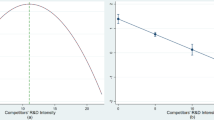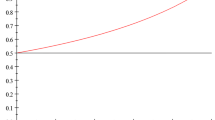Abstract
In this paper, we apply a dynamic option-game framework to examine the impact of information time lag on Research and Development (R&D) investment in innovative information technology (IT) industry. We focus on incentives of competition and coordination in R&D. Our results show that shorter information time lag may induce firms to coordinate their investments and avoid over-investment. The threshold of information time lag developed in this paper can facilitate managerial decisions on whether to compete or coordinate R&D investments.



Similar content being viewed by others
References
Berk JB, Green RC, Naik V (2004) Valuation and return dynamics of new ventures. Rev Financial Stud 17(1):1–35
Benaroch M, Kauffman RJ (1999) A case for using real options pricing analysis to evaluate information technology project investments. Inf Syst Res 10(1):70–86
Benaroch M, Lichtenstein Y, Robinson K (2006) Real options in IT risk management: an empirical validation of risk-option relationships. MIS Qtrly 30:827–864
Dixit AK (1993) The art of smooth pasting, vol 55 in fundamentals of pure and applied economics. Harwood Academic Publishers, London
Dixit AK, Pindyck RS (1994) Investment under uncertainty. Princeton University Press, Princeton
Dockner EJ, Jorgensen S, Long NV, Sorger G (2000) Differential games in economics and management science. Cambridge University Press, Cambridge
Evans DS, Schmalensee R (2001) Some economic aspects of antitrust analysis in dynamically competitive industries. In: Jaffe A, Lerner J, Stern S (eds) Innovation policy and the economy, vol. 2. pp 1–50
Fichman RG (2004) Real options and IT platform adoption: implications for theory and practice. Inf Syst Res 15(2):132–154
Garlappi L (2004) Risk premia and preemption in R&D ventures. J Financial Quant Anal 39(4):843–872
Green EJ, Porter RH (1984) Noncooperative collusion under imperfect price information. Econometrica 52(1):87–100
Grenadier SR (1996) The strategic exercise of options: development cascades and overbuilding in real estate markets. J Finance 51(5):1653–1679
Haurie A, Krawczyk JB, Roche M (1994) Monitoring cooperative equilibria in a stochastic differential game. J Optim Theory Appl 81(1):73–95
Huisman KJM (2001) Technology investment: a game theoretic real options approach. Kluwer Academic, Dordrecht
Kwoka JE, White LJ (2004) The antitrust revolution: economics, competition, and policy. Oxford University Press, Oxford
Miller P, O’Leary T (2005) Managing operational flexibility in investment decisions: the case of Intel. J Appl Corp Finance 17(2):87–93
Morse MH (2001) The limits of innovation markets. ABA Antitrust and Intellectual Property, Newsletter
Nocke V (2006) Collusion and dynamic (under-) investment in quality. Forthcoming. RAND J Econ
Schwartz ES, Zozaya-Gorostiza C (2003) Investment under uncertainty in information technology: acquisition and development projects. Manag Sci 49(1):57–70
Shapiro C (2002) Competition policy and innovation. OECD
Shapiro C (2005) Antitrust, innovation, and intellectual property: testimony before the antitrust modernization commission. Available at http://www.faculty.haas.berkeley.edu/shapiro/amcinnovation.pdf
Smets F (1991) Exporting versus foreign direct investment: the effect of uncertainty, irreversibilities and strategic interactions. Working Paper, Yale University
Weeds H (2002) Strategic delay in a real options model of R & D competition. Rev Econ Stud 69(3):729–747
Yao T (2005) R&D investment dynamics under uncertainty: theory and application. Ph.D. dissertation, Stanford University
Zhu K (1999) Evaluating information technology investment: cash flows or growth options? In: Proceedings of the workshop on information systems economics (WISE99)
Acknowledgments
This paper was first presented at the Conference on Information Systems and Technology (CIST) 2005. The paper was accepted by Dr. Indranil Bardhan, Alok Gupta and Paul Tallon, Guest Editors and program co-chairs of the conference.
Author information
Authors and Affiliations
Corresponding author
Appendix
Appendix
Proof of Proposition 1
Consider a suitably smooth function \( J^{i} ,i \in \{ A,B\} \), satisfying the Hamiltonian-Jacobian-Bellman (HJB) equation:
where
where the subscript J refers to the partial derivative.
The expected payoffs follow from the above HJB equation (23). The parameters can be solved by applying boundary conditions, value matching conditions, smooth pasting conditions, and transitional boundary conditions. For discussions of the above conditions, see Dixit [4], Berk et al. [1], and Yao [23].
Proof for Corollary 1
From Eqs. 6 and 7, \( x^{L*} = x^{F*} = x^{N*} \), we have Eq. 9. It can be shown that the threshold \( x^{N*} \)as in Eq. 9a and coefficients as follows:
Proof of Proposition 2
Similar as the proof of Proposition 1. Consider a suitably smooth function J C, satisfying the Hamiltonian-Jacobian-Bellman (HJB) equation:
where
where the subscript parameter of J refers to the partial derivative.
The expected payoffs follow from the above HJB equation (24). The parameters can be solved by applying boundary conditions, value matching conditions, smooth pasting conditions, and transitional boundary conditions.
Proof for Corollary 2
From Eq. 10, \( x^{CL*} = x^{CF*} = x^{C*} \), we have Eq. 12. It can be shown that the threshold \( x^{N*} \) as in Eq. 12a and coefficients as follows:
Proof of Theorem 1
First note that
If \( \delta \le \delta^{L*} \), then \( \delta \le \delta^{L} (x) \) for all x. From (25), it can be shown that \( f_{1} (x,\delta ) < 0 \), then the corresponding strategy profile \( \psi = (\psi^{A} ,\psi^{B} ) \) defined in (4) constitutes a Nash equilibrium for the history-dependent game.
Similarly, if \( \delta > \delta^{H*} \), then \( \delta \ge \delta^{H} (x) \) at least for some x. From (25), \( f_{2} (x,\delta ) > 0 \), then the corresponding strategy profile \( \psi = (\psi^{A} ,\psi^{B} ) \) defined in (4) fails to constitute a Nash equilibrium for the history-dependent game.
Rights and permissions
About this article
Cite this article
Yao, T., Weyant, J. & Feng, B. Competing or coordinating: IT R&D investment decision making subject to information time lag. Inf Technol Manag 12, 241–251 (2011). https://doi.org/10.1007/s10799-011-0105-6
Published:
Issue Date:
DOI: https://doi.org/10.1007/s10799-011-0105-6




